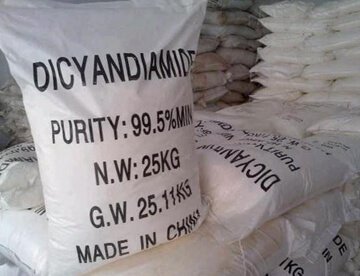Dicyandiamide

We offer dicyandiamide from a warehouse at competitive prices with delivery throughout Russia.
Specification (table)
Purity 99.5% min
Moisture content 0.3% max
Loss when heated 0,3% max
Ash content 0.05% max
Calcium content 0.02% max
Description
Dicyandiamide, DCDA, N-cyanoguanidine
Molecular weight 84.03. Colorless crystal. Poorly soluble in water.
The dicyandiamide is a nitrile derived from guanidine. This is a dimer of cyanimide from which it can be prepared. Dicyandiamide is a colorless solid that soluble in water, acetone and alcohol, but not nonpolar organic solvents.
Solubility in water of 3.3% at 20°C. Not hygroscopic. Soluble in alcohol, worse-in the air. Melting t 210°C. the Density of 1,386-1,405 g/cm3. The heat of formation is 24.9 kJ / mol. The heat of combustion is 1382 kJ / mol. Heat capacity at 298.15 K 1674 j / (kg·K), thermal conductivity of 0.85 W/(m·K).
Low toxicity, but with systematic contact causes dermatitis. Obtained by dimerization of cyanimide, which in turn is obtained from calcium cyanimide.
Application
In the chemical industry, Dicyandiamide is used as a raw material for the production of hot-curing epoxy resins, glue, for the synthesis of guanidine and melamine.
Use it as a binder for varnishes and paints. It can be used as a raw material for the production of plastics.
In the pharmaceutical industry-in the process of synthesis of antimicrobial drugs.
In light industry, it is used as a binder for dyeing fabrics.
In the wood industry, Dicyandiamide is indispensable as a component of fire (flame retardant) impregnation for wood products.
Used as a product in the org. synthesis, as a stabilizer of nitrocellulose, fertilizer. In the manufacture of organic fertilizers, it is used as a reagent as an activator.
It is used in pyrotechnics as fuel, which has the properties of a flame arrestor, and therefore it is used in signal smoke compositions. It is also used in gas-generating compositions of pyrotechnic fountains.

